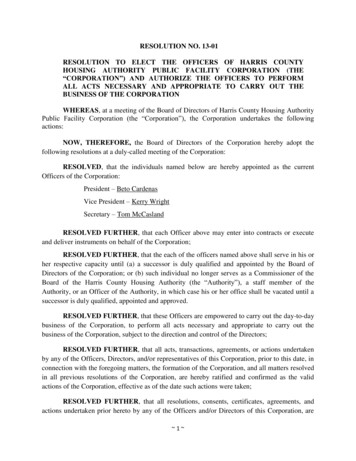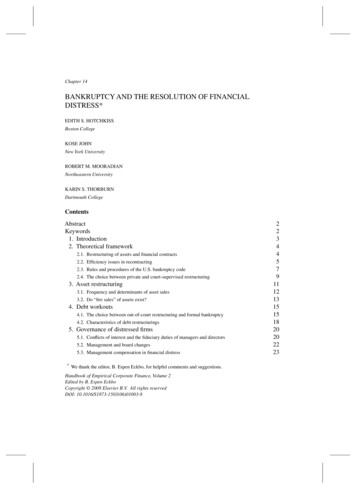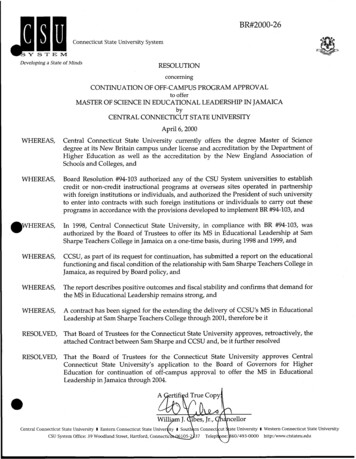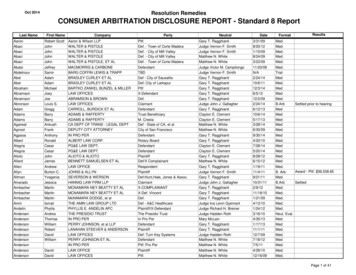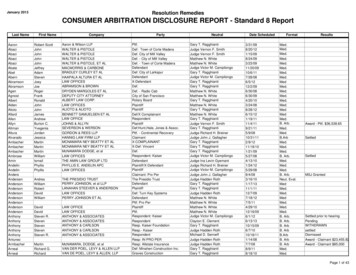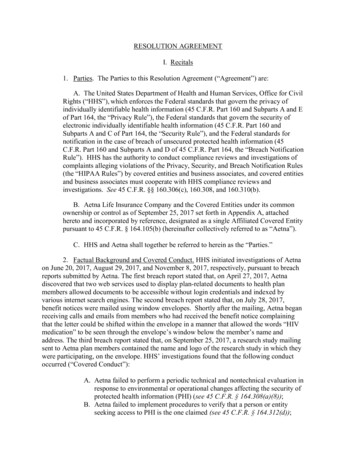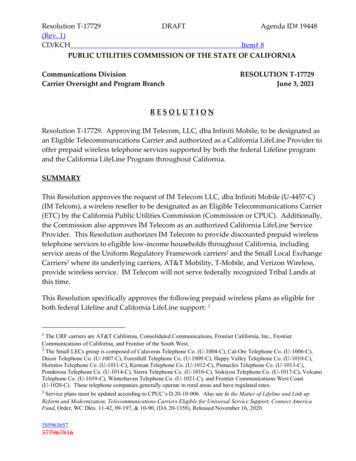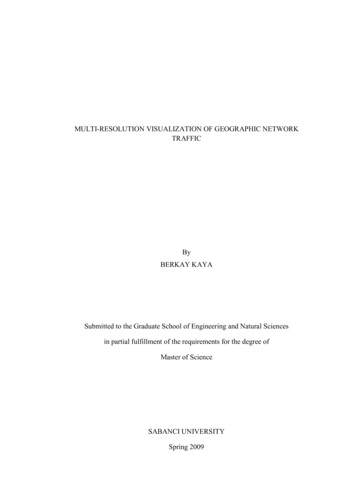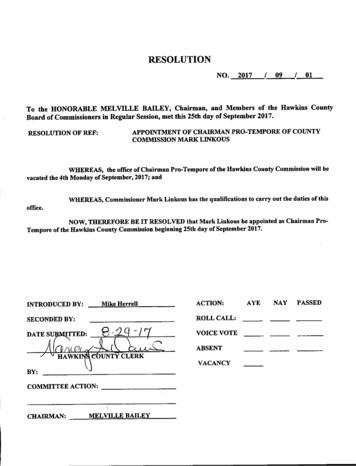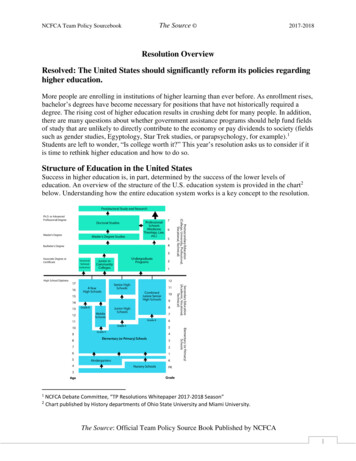
Transcription
NCFCA Team Policy SourcebookThe Source 2017-2018Resolution OverviewResolved: The United States should significantly reform its policies regardinghigher education.More people are enrolling in institutions of higher learning than ever before. As enrollment rises,bachelor’s degrees have become necessary for positions that have not historically required adegree. The rising cost of higher education results in crushing debt for many people. In addition,there are many questions about whether government assistance programs should help fund fieldsof study that are unlikely to directly contribute to the economy or pay dividends to society (fieldssuch as gender studies, Egyptology, Star Trek studies, or parapsychology, for example).1Students are left to wonder, “Is college worth it?” This year’s resolution asks us to consider if itis time to rethink higher education and how to do so.Structure of Education in the United StatesSuccess in higher education is, in part, determined by the success of the lower levels ofeducation. An overview of the structure of the U.S. education system is provided in the chart2below. Understanding how the entire education system works is a key concept to the resolution.12NCFCA Debate Committee, “TP Resolutions Whitepaper 2017-2018 Season”Chart published by History departments of Ohio State University and Miami University.The Source: Official Team Policy Source Book Published by NCFCA1
NCFCA Team Policy SourcebookThe Source 2017-2018The next step is to get a broad overview of the components of the higher education system. Thereare several types of institutions of higher education.Public Colleges and UniversitiesPublic colleges and universities receive funding by local and state governments. Their tuitionrates are typically lower than a private college, although some institutions have out-of-statetuition rates for non-residents of the state where the college is located. States tend to cut fundingto higher education institutions when state budgets get tight. Since 2008, there has been asignificant decrease in state funding, which the federal government has sought to replace throughan increase in Pell grants, tax exemptions, and loans.Four-year and Two-year CollegesFour-year colleges, public or private, offer programs that lead to a bachelor’s degree, while twoyear colleges offer programs that lead to a certificate or an associate degree. Universities andliberal arts colleges are four-year colleges. Universities are often larger and offer more majorsand options for bachelor degree programs, as well as master’s and doctoral degrees. Two-yearcolleges are public and include community colleges, vocational-technical colleges and careercolleges.3Private Colleges and UniversitiesDespite the perception that private institutions run on large endowments, these schools doreceive federal funds in the form of grants, contracts, and taxpayer subsidies. Endowments andtuition are only a portion of their support. They do enjoy private governance, even with thepublic subsidies. 4For-Profit Colleges and UniversitiesFor-Profit colleges are businesses that offer degree programs typically directed towardspreparing students for a specific career. Prices can be higher than public or private colleges andthe demographic is usually students who cannot afford the higher costs, which in turn, results inmore debt. Completion rates are also low. Accreditation programs and policies that govern howthey receive financial support tend to need more oversight to avoid corrupt practices and theexploitation of lower income students.5StakeholdersPostsecondary education is a partnership between federal, state, and local governments, alongwith the individual institutions and other stakeholders, such as the students and companieslooking for competent workers. Stakeholders in this partnership have different and competinginterests. For example, professors want to educate students in their chosen field, but also havepersonal interests such as tenure and reputation. Students want a good education that will helpthem get a “good” job. Business want students equipped with the needed skills, while society isinterested in producing good citizens and economic 385810/4The Source: Official Team Policy Source Book Published by NCFCA2
NCFCA Team Policy SourcebookThe Source 2017-2018State InvolvementThe resolution allows students to pick cases that reform policies of the federal government or thestates. The 10th Amendment to the Constitution assigns education as a function of the states. Thedegree of control varies by state. Colleges can enjoy autonomy as separate branches of stategovernment, such as University of California, or states, such as Texas and Montana, may have agoverning body that oversees establishing accountability measures, setting policies, or approvingacademic programs. In some states, the state board has only an advisory role and little directauthority over the institution.6Many of the states’ concerns are related to the federal government using funding as leverage tocoerce states into fulfilling federal policy objectives. In the past, state appropriations have madeup the bulk of the financial support at public institutions. Those appropriations are diminishingas state economies force budget cuts. State governments and institutions have raised tuition,shifting responsibility from the taxpayer to the student. Case areas could focus on finding thebalance between states’ rights and the education concerns of the federal government.Federal InvolvementAccording to the U.S. Department of Education, education is primarily the responsibility ofindividual states, and federal involvement is described as “a kind of ‘emergency responsesystem,’ a means of filling gaps in State and local support for education when critical nationalneeds arise.”7 After The Great Recession in 2008, higher education funding from the federalgovernment has risen to fill in the gaps from a lack in state funding.8 The Department ofEducation is the sole lender for student loans and does not seem well equipped to handle the 1.3trillion dollar debt. This Student Debt Crisis is the focus of the argument over federal funding,which includes Pell grants, tax credits, and other subsidies.Additionally, the Task Force on Higher Education released a report in February 2015 describingfederal regulations as “unnecessarily voluminous”, and chronicle in detail the overabundance ofregulatory documents and requirements for colleges and universities in every state.9 In 2012alone, more than one new directive or clarification was issued every single working day of theyear. Many researchers suggest that this regulatory overload can and should be reduced in favorof state, local, or self-regulation.Accreditation organizations have been set up to monitor quality assurance of institutions ofhigher education. They determine whether institutions qualify for federal funding programs ifthey are meeting established minimum standards. However, they do not compare institutions ,accessed of-Higher-EducationMain.aspxThe Source: Official Team Policy Source Book Published by NCFCA3
NCFCA Team Policy SourcebookThe Source 2017-2018one another or mandate how institutions meet the standards.10 Some accreditation organizationsface accusations of fraud and corruption, supplying more areas for reform.Individual Institution’s InterestsOne final perspective to consider is the individual institution. Colleges are not always affected bymarket forces the way other sectors of the economy typically react. Students choose to attendschools based on factors other than finding the best value for their money, partly because it is sodifficult to define the value of the college experience.In addition to the lack of market forces, colleges can be immune to policy changes, asAdministrators and professors claim academic freedom when politicians begin wanting too muchoversight. The government has tried to hold colleges more accountable through policies such asHigher Education Act, the 2008 Higher Education Opportunity Act, and the College Scorecard in2013, the latter of which can be used to roughly determine interest by prospective students. Somearticles argue that the various government regulations are unnecessary or even harmful toeffective education, while researchers struggle to determine, even on a basic level, what it is thatdefines effective education.Students this year will find many case areas ripe for proposing change, as well as documentationfor opposing those changes.Areas of FocusThe following general categories are meant to help categorize the cases for research andorganization.1) Funding reforms and Monetary IncentivesThis category encompasses reforms focusing on federal or state funding and the resultingregulations produced by these incentives. Included, are policies that would revoke thebankruptcy provision of the Higher Education Act or putting caps on federal studentloans. Cases could address ideas like creating educational savings accounts for studentsthat they are allowed to access when enrolling in a post-secondary school or cuttingsubsidies to for-profit colleges by reforming the 90/10 Rule. Another alternative isIncome Sharing Agreements, such as Purdue’s program11. These topics showcaseincentive-based regulations and removing extensive regulations.2) Teacher-Based ReformsAnother category includes policies changing how professors are paid, evaluated, teach, orare hired and fired. This would extend from ideas like revoking federal or state evaluationpolicies in favor of local evaluations to ideas such as ending tenure and replacing withperformance-based funding. Identifying the perspective of the teacher-based reforms n-studentdebt/519570/The Source: Official Team Policy Source Book Published by NCFCA4
NCFCA Team Policy SourcebookThe Source 2017-2018be especially useful as many people have experience and/or strong opinions about thesecase areas.3) Individual Rights ReformsThis category includes all of the issues seen in recent news stories, such as free speech,gun rights, undocumented immigrants, academic freedom, civil rights, and social issues.States handle these issues differently,12and federal involvement may escalate as a result.2017 should see states and the federal government working to make changes in order toimprove student’s lives and the accessibility and affordability of higher education. Statesand the federal government need to work together to solve these pressing and quicklyevolving issues.4) Other Case Areas for ReformOther areas that should be researched to find out the need for reform deal with giving taxbreaks to students who pursue degrees in high-demand fields, such as STEM fields, andcracking down on subsidy reliance for private schools. Another related area is the idea ofperformance based funding, or reforming the accreditation process. There is growingconcern surrounding the question of whether or not colleges should be held accountablefor job preparation.This overview is a springboard to begin researching the debate topic. The topics and categoriescovered here are not exhaustive, nor is this short article meant to take the place of the broadreading that is needed for a comprehensive understanding of the debate resolution. Students areresponsible for the information they use, and are encouraged to thoroughly check sources tounderstand the context and any bias before they use quotes as evidence. This topic is deceptivelylarge, but it is very interesting. Parents, students, and judges will all have a vested interest in theideas debated this year. Dive in and have fun learning!Happy ions/policy-matters/Top10Issues2017.pdfThe Source: Official Team Policy Source Book Published by NCFCA5
there are many questions about whether government assistance programs should help fund fields of study that are unlikely to directly contribute to the economy or pay dividends to society (fields such as gender studies, Egyptology, Star Trek stu
